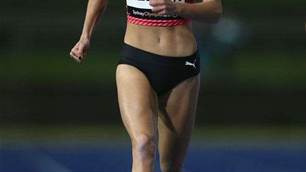How a clothes designer earned women's tennis its rightful place alongside the blokes.
But unfortunately, the women’s game was rarely judged on its merits. Instead, it was compared to the men’s game. The logic has always seemed faulty, something like criticising cats because they’re not like dogs, or beef jerky for lacking the properties of blancmange.
Ted Tinling helped change all that way back in the 1940s. Responding to accusations that the women’s game was “boring”, Tinling decided the time had come to make it glamorous. He started with a dazzling bang when, in 1949, he was instigator of one of the most controversial episodes in tennis history.
Cuthbert Collingwood “Ted” Tinling, born in 1910 in Eastbourne, England, began playing tennis on the French Riviera in 1923 as a cure for asthma. It was at Nice Tennis Club that he met the game’s biggest star, Suzanne Lenglen. He ended up umpiring over a hundred of her matches. His own career as a player was brief, but as a young man he already ran one of the more successful Mayfair fashion houses.
It was his connection with Lenglen that led him to be offered the role of player liaison at the Wimbledon Championships, a position that lasted from 1927 until 1949. During the hiatus for World War II, he was a Lieutenant-Colonel in the Intelligence Corps in Algiers and Germany. In fact, it was revealed after his death in 1990 that Tinling had been a spy for British intelligence during the war.
Upon his return, Tinling designed female playing apparel. He immediately threatened to open the gate to fashion anarchy in 1947 when he’d included an unobtrusive band of colour on a dress worn by Joy Gannon. Immediately there was clamour for even more colour. The All-England committee was forced to stem the tide by declaring only white would be worn for its 1949 tournament.
The Gussie Moran furore, which led to “Gorgeous Gussie’s” near-breakdown and Tinling’s sacking and ostracism by Wimbledon officials, was the real beginning of Ted’s career as a tennis couturier. It began when the relatively shy and modest Moran asked Tinling, who was then-Wimbledon host, to design a dress for her first appearance at the tournament.
The result was, in its day, an outrageous outfit, designed so the frilly knickers worn under the dress, rather than the dress itself, would feature. The dress was, therefore, shorter than anything anyone had seen before, especially on the staid greens of Wimbledon. To be fair to Tinling, Moran wanted something different. She suggested an outfit with different-coloured sleeves, which Teddy knew would be immediately rejected by Wimbledon officialdom. Blinded by the whiteness of Moran’s new getup, they never anticipated there would be a problem with it.
Moran did. She only wore the outfit once, and when she did, she walked onto the court hiding her face behind her racquet. “
Gorgeous Gussie” (she preferred to spell it “Gussy”, but seemed to have little say in the matter) had stumbled into tennis folklore.
Photographers, all lying prone at courtside – without cameras in their hands they’d have been arrested – sent shots of Gussie’s pleated panties around the world. Heated Parliamentary debate ensued. The All-England Lawn Tennis and Croquet Club was in agreement with scandalised religious leaders and accused Moran and Tinling of bringing “vulgarity and sin into tennis”.
Teddy was shunned by the committee for 33 years. Meantime, he gained worldwide recognition for his fashion creations, worn by greats of the women’s game, including the Wimbledon ladies’ champions in 1959, 1960, 1961, 1964, 1969, 1971, 1972, 1973, 1975, 1977, 1978 and 1979. That spans a magnificent era, from Moran to Navratilova. The last Tinling dress worn at Wimbledon was by Rosemary Casals in 1984. Teddy also designed Chris Evert’s wedding dress in 1979.
He was invited back to Wimbledon in 1982, but by that time he was no stranger to tennis watchers. We were used to seeing the flamboyant, gangling designer of 6’7”, with his chunky jewellery and shaven head on TV talking about the women’s game. His extensive knowledge and intelligent analysis were often second-fiddle to his eccentric campiness.
It was the lace undies of Moran that catapulted Teddy to international fame, and infamy, and though he became known as a dressmaker to the stars, he’d morphed, during his Wimbledon exile, into an important spokesperson for the women’s game as International Tennis Federation Chief of Protocol 1978-90, Federation Cup Chief of Protocol and on-court host from 1978-90, and International Liaison Director of the Virginia Slims tournament started by his friend, Billie-Jean King, from 1982 to his death in 1990.
Though Tinling was 80 when he died, his death was untimely, and it was a shock when he succumbed to the very respiratory illness that led him to tennis at the beginning of the 20th Century. He was a towering figure in every sense.
Related Articles

Will our Olympians bounce back at this year's Games?

Ella Nelson has already beaten a few of world's best













